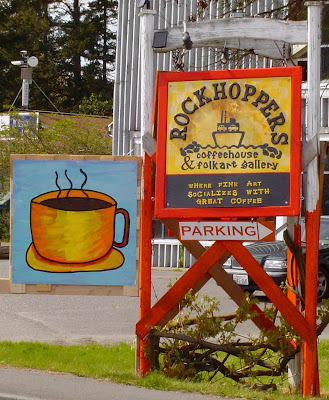
When I started this shop I decided that the art I do is definitely folk art. I love what I do and spend hours doing it but have had NO art training and I tend to use items found our unusual to work on or with. I used the definition of folk art as defined by wikipedia (who else?) and further defined by the National Folk Art Society. Our definition of folk art is (1) Art that is not representational of fine art and is done by artists who have had no formal art education, (2) Art that is done using found items or traditional items in a non-traditional way, (3) Art that is done with in a certain culture and has been passed down through the generations IE. quilting, or doll making, crocheting etc. (4) Art that is done "in the rough" so to speak. I have extended the definition to include art that is done using unusual mediums (for example: Michael Patterson's pieces done with paper pulp or his yarn pieces.)In truth, this covers a wide range of art and some of the pieces we have had in my shop can be considered fine art.

Recently I found an article on the net discussing the difference between crafting and art. I have to admit this debate stirred up some feelings that got me exploring the issue of fine art and folk art again. Since some folk art does appear as crafting through it's simplicity but then I have seen a few pieces that are defined as fine art and they could not be simpler.. a red dot in a sea of white... a white canvas... a red canvas... etc. In fact I hear comments about how people's children could do some of that fine art and I find myself agreeing! So after reviewing the discussion and not participating i find myself participating now.

Fine art as defined by Rene Schlangen, is art that requires a degree of talent that will be recognized for years to come. True fine art is not art that becomes famous because of the commercial clout that the artist's patrons have but because it cannot easily be duplicated and the techniques cannot easily be mastered. Fine art covers all forms of art that fall under this definition and does not limit itself to painting. Many forms of quilting, embroidery, ceramics, design work etc fall under this definition.

Folk art remains as defined by myself when establishing this shop.

Crafting is art created for the express purpose of fun and pleasure. It is not something that will last for a long period of time generally. Crafting is something that is short lived, and generally utilitarian. It requires skill that is basic but with time can be developed. Once a crafter becomes experienced in a specific skill i.e. quilting then they move on to folk art or fine art depending upon the direction they take.
OK, here is the rub. I do not believe that a fine artist is defined by the amount of schooling they receive. Talent does not come from schooling it is only refined by schooling. The same thing can be achieved by spending time painting and studying other masters. If schooling was a necessary adjunct to fine art then masters such as Van Gogh, or Gauguin or Cezanne would simply have been classified as folk artists and they never would have had the impact on the art world that they did. In fact much of the earlier art done in the impressionist style would have fallen under the folk art name as outsider art! Fine art is simply art that defines a style and expertise that is beyond that of folk art or crafting. HOWEVER... I do not believe that folk art and fine art are mutually exclusive of one another! Art in truth has no real definition so it cannot have any real boundaries.

So now that this discussion is clear as mud.. let's just say that I enjoy folk art, fine art and crafting.. it is all creating something from nothing and no matter what it is we are doing it results in thought, smiles, tears, joy or just plain loathing and the world is better for us having created it! Generally!

Folk Art on Whidbey Island.
No comments:
Post a Comment